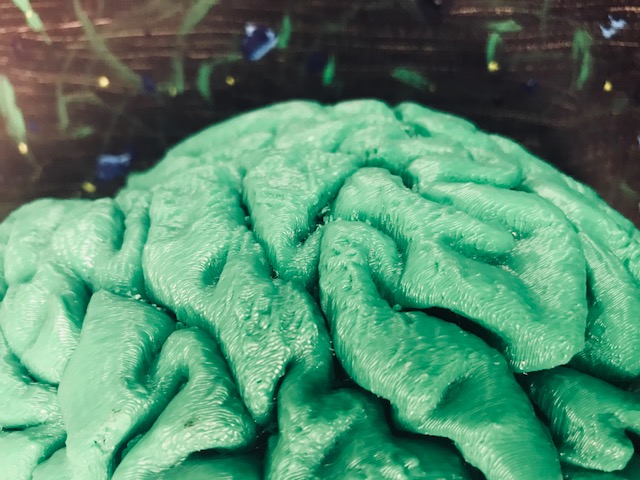How much energy does a brain require? How many brain cells do we have? Are humans unique in terms of brain size, number of neurons – or social skills, tool use, deception, or play..? How do you make “brain soup?” And what’s the best way to bring fresh cerebrums on an international flight?!
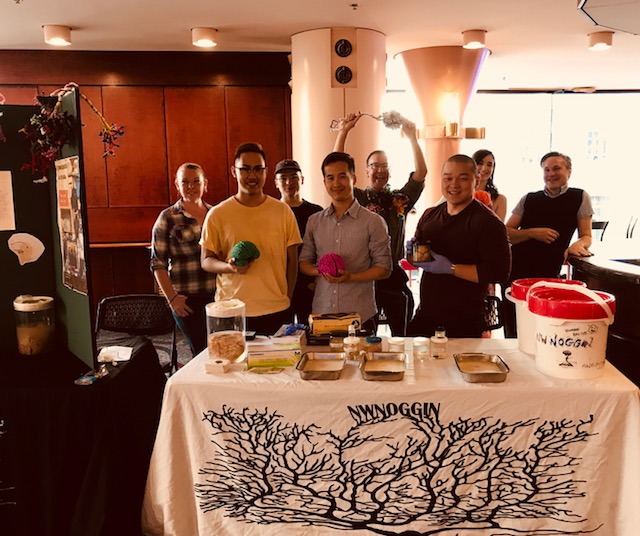
We gathered an excited crowd of Noggin volunteers at Portland’s Newmark Theater during Oregon STEM Week (and also, according to Governor Kate Brown, Oregon’s STEAM Education Week!) to hear answers from Suzana Herculano-Houzel, a Brazilian-born neuroscientist and associate professor at Vanderbilt University.

Dr. Herculano-Houzel studies what different animal brains are made of, and developed a new, effective technique for counting cells. She recently published The Human Advantage, describing her research – and how cooking allowed us to exist!
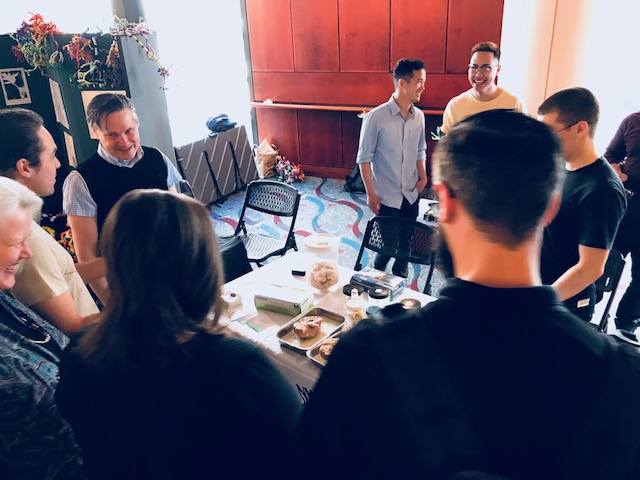
Our accomplished participants included Alex Chao, Dustin Lao and King Tran from the Freshman Inquiry (FRINQ) University Studies course sequence on the Neuroscience of Creativity & Learning at Portland State University…
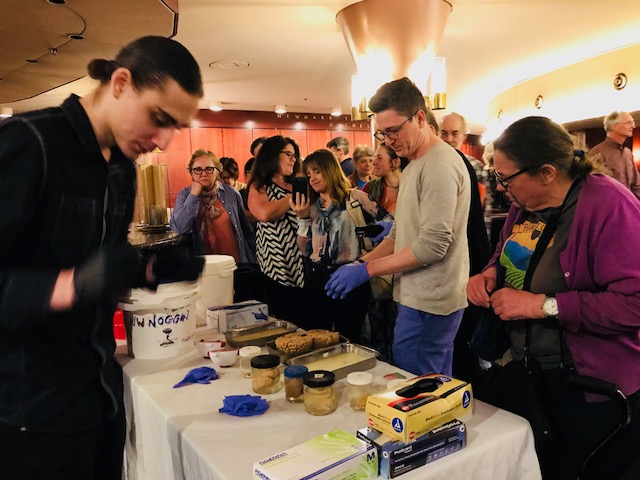
LEARN MORE: Science of Creativity & Learning PILOT 2018
They were joined by additional PSU volunteers Ashley Keates, Austin Lewis, Aaron Eisen and Heather Hamilton (who is also an NIH BUILD EXITO scholar), and Jacob Schoen from the Oregon National Primate Research Center at OHSU…

This talk, the first of three in the OHSU Brain Awareness Lecture Series, was promoted as “Trade Food for Thought to Power 86 Million Neurons,” a title which includes a rather ironic numerical error for the scientist who accurately counted the number of cells in our brains!
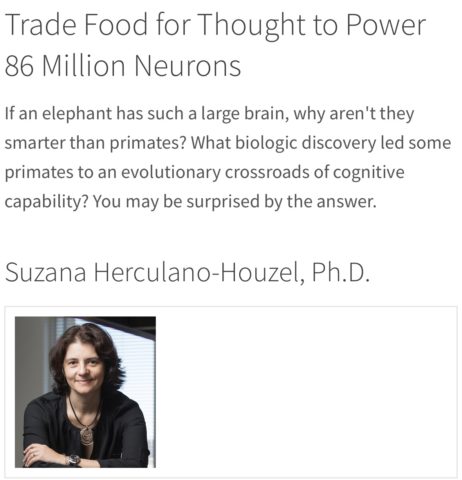
*** It is definitely NOT 86 million neurons – it’s 86 BILLION!

LEARN MORE: The Human Brain in Numbers: A Linearly Scaled-up Primate Brain
LEARN MORE: Nourishing Your Neurons: How you fuel your brain creates pivotal changes
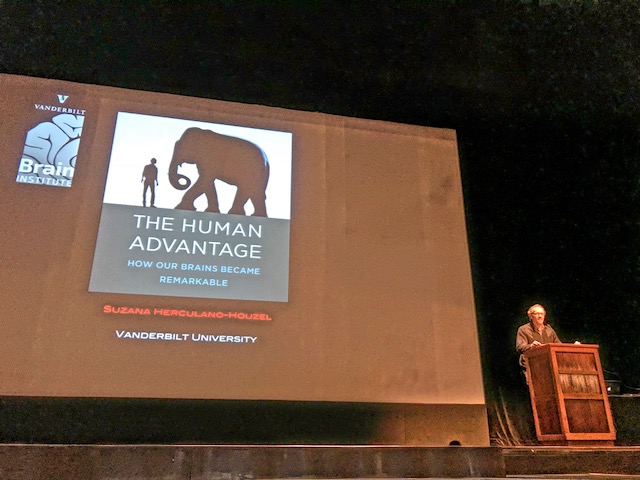
Fellow Brazilian-born neuroscientist Claudio Mello, who was recently awarded a $1 million National Science Foundation grant for his speech and language research on neurologically well-endowed songbirds at OHSU, introduced Dr. Herculano-Houzel, noting that she was the first Brazilian woman to give a TED talk…
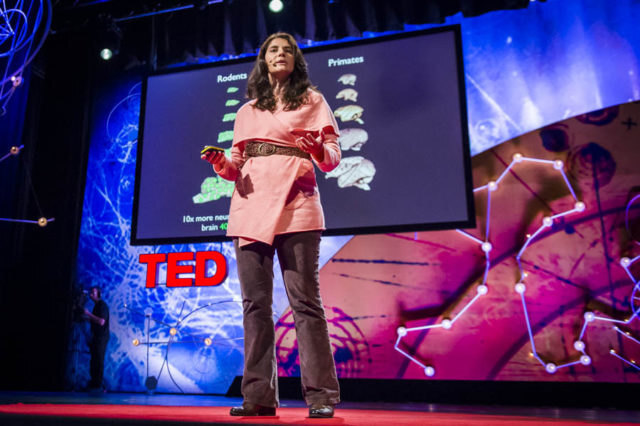
TEDGlobal 2013 in Edinburgh, Scotland, 2013. Photo: James Duncan Davidson
LEARN MORE: What is so special about the human brain?
He reminded us that Brazilians “speak Portuguese, not Spanish, our capital is Brasilia, not Buenos Aires, and the best football player is of course Pelé, not Maradona..!”

LEARN MORE: Pelé vs Maradona: A statistical comparison of the world’s two greatest footballers
Dr. Herculano-Houzel, added Dr. Mello, is also a prolific and celebrated science communicator, supplementing her research publications with a popular column in Folha de S. Paulo, the country’s most-read newspaper published in São Paolo, Brazil…
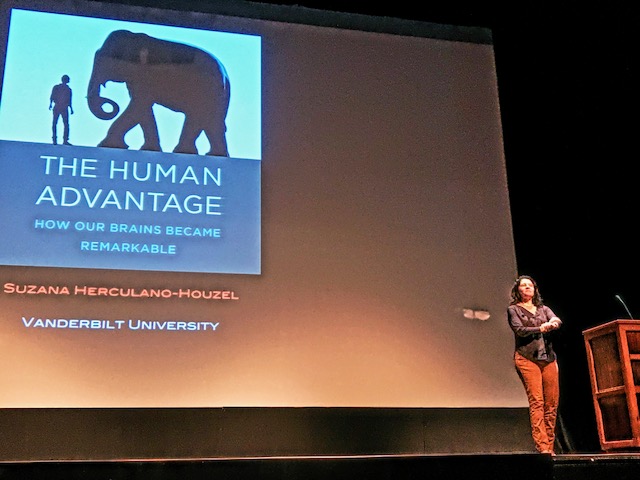
“Why is it that we study animals, instead of them studying us..?” she began. For the longest time, human brains have been considered remarkably special. It’s been alleged that we have the most neurons (we don’t), plus 10 to 50 times more glial cells (it’s closer to 1:1), and that our gigantic brains are unusually large in relation to our bodies (that’s not true either)…
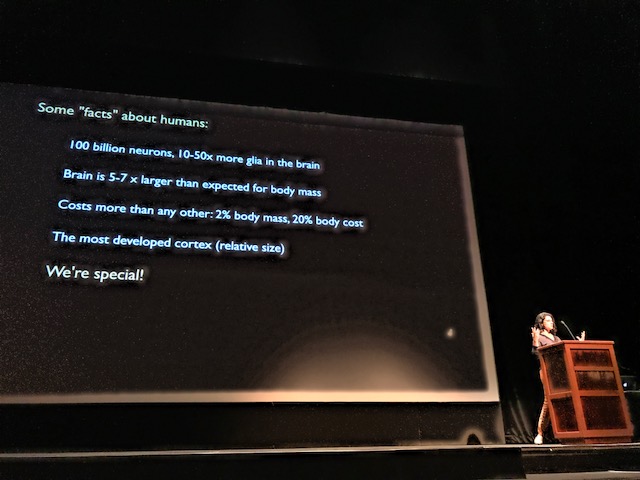
“Hubris and science are incompatible…” –Douglas Preston
LEARN MORE: The search for true numbers of neurons and glial cells in the human brain
LEARN MORE: The remarkable, yet not extraordinary, human brain
For almost 15 million years, she explained, there was little change in the size of the primate brain, but around 2 million years ago there was a sudden “inflection in the curve…”

The inside of the primate skull became bigger and bigger “at an incredibly fast pace,” and around 200,000 years ago, modern humans (homo sapiens) appeared. These discoveries only added to the story of how special we seemed to be…
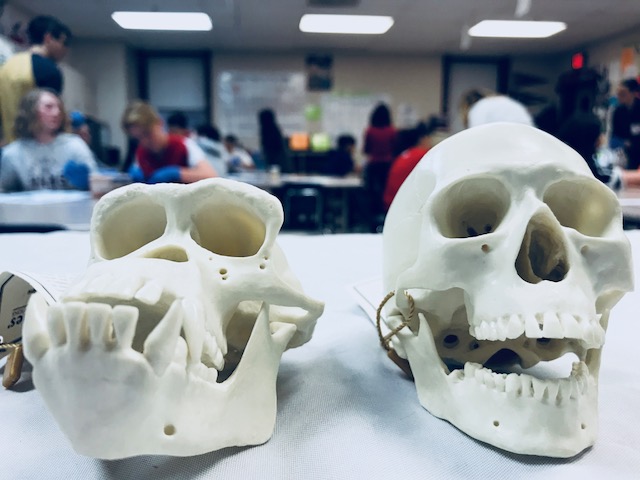
LEARN MORE: Primate cranial diversity
LEARN MORE: The origin and evolution of Homo sapiens
LEARN MORE: The evolution and development of cranial form in Homo sapiens
LEARN MORE: Hominin interbreeding and the evolution of human variation

We also use symbols, language and tools, and can plan and reason, recognize ourselves and grasp that others possess minds that might not be privy to the same information we have. These were thought to be traits unique to humans, yet according to Dr. Herculano-Houzel, “more and more stubborn people” discovered that they can teach great apes to sign, that crows use and make tools (including hooks!), that magpies can recognize marks placed on them by experimenters, and that chimpanzees can deviously plot and deceive…
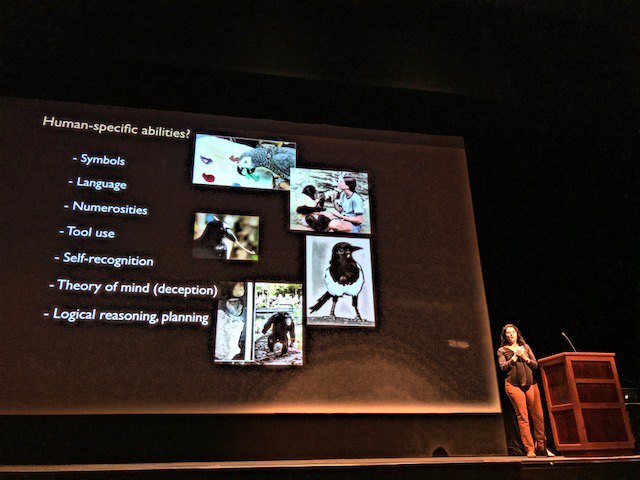
LEARN MORE: Planning of the Apes: Zoo Chimp Plots Rock Attacks on Visitors
LEARN MORE: Stone-Throwing Chimp Is Back — And This Time It’s Personal
LEARN MORE: Apes Communicate about Absent and Displaced Objects
LEARN MORE: Tool use by wild New Caledonian crows Corvus moneduloides at natural foraging sites
LEARN MORE: A novel tool-use mode in animals: New Caledonian crows insert tools to transport objects

Chimps can even play video games!
“Imagine if you gave your son a treat every time he did well on a video game…”
“We’re talking about a chimpanzee who has the ability to identify little squiggles on a screen that this other crazy species decided have a certain order to them and recall what was where and which comes first – a bunch of abilities that we’d like to assume belong just to our species – but clearly don’t…” declared Dr. Herculano-Houzel.
LEARN MORE: Chimps outperform humans at memory task
LEARN MORE: Do young chimpanzees have extraordinary working memory?
“I’m here to tell you that your brain is not special – but it’s still really, really cool!”
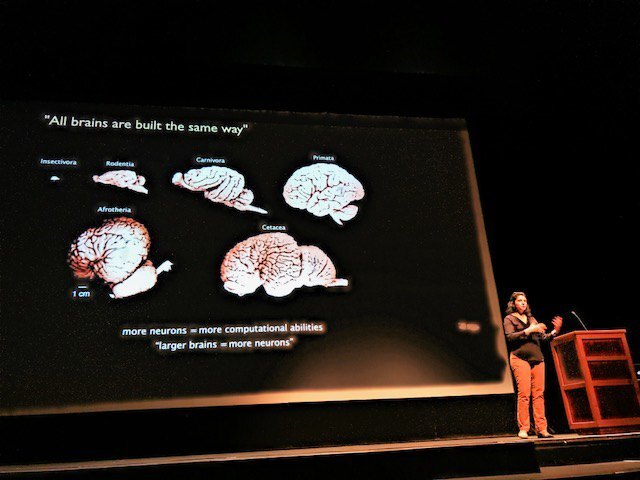
“How can all these different species display these same abilities to different extents?” asked Dr. Herculano-Houzel. “Are these based on differences in brain quantity?”
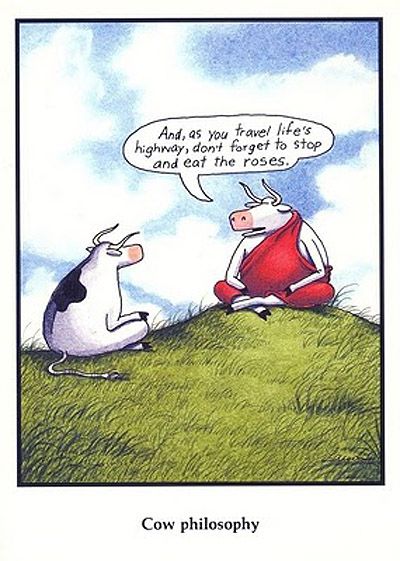
From Gary Larson, The Far Side
So is it brain size that matters? Chimpanzee brains weigh about 420 grams, less than the 425 – 458 gram average weight of a cow brain! “So these cows,” she mused, “are they engaged in deep philosophical thoughts? Just not letting us in?” Human brains aren’t the heaviest, either, at around 1300 – 1500 grams. We are dwarfed by elephants (5200 grams), and a sperm whale brain is over 7500 grams! “It’s a vexing problem.”
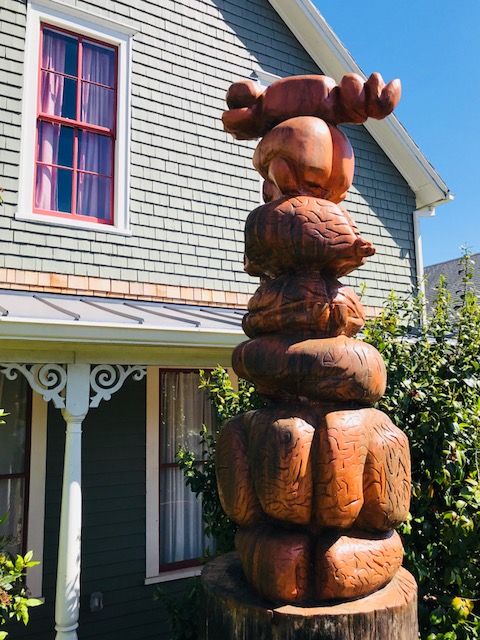
Column of Regional Brains, Astoria, Oregon by Matt Cartwright. From the top: salmon, crow, sea lion, black bear, (squished) human, humpback whale.
LEARN MORE: Brain Facts and Figures (Neuroscience for Kids)
Brains are also very expensive in terms of energy use. While our brains make up 2% of our body’s weight, they consume about 20% of the calories. Larger brains may offer great advantages for behavior, but they don’t come cheap.
LEARN MORE: Appraising the brain’s energy budget
So one evolutionary strategy for supporting bigger brains, like the elephant brain, is to build a bigger body. Bigger animals have bigger mouths that can consume more food faster. But an elephant is awake and eating at least 18 hours a day!
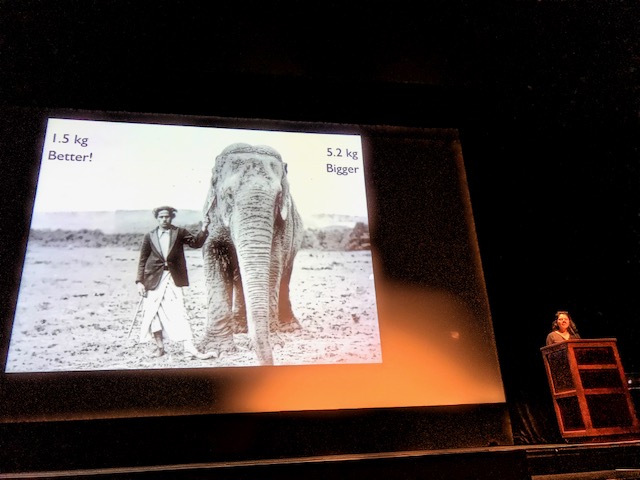
Yet again, humans do not have the biggest brains…
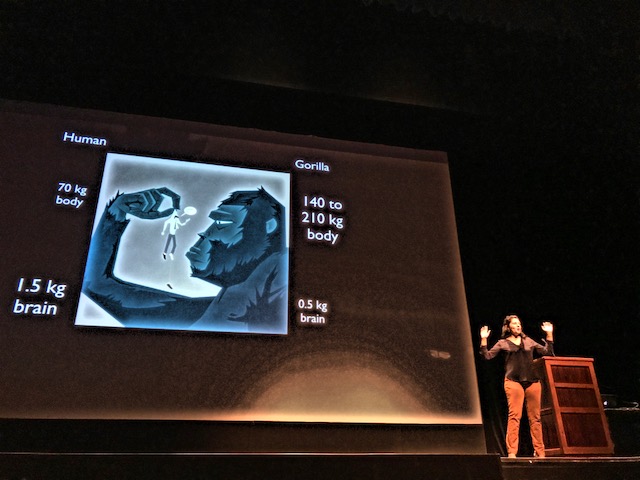
Or the biggest bodies…
So perhaps not all brains are built in exactly the same way? “Being a perfect outsider to the field – I felt that I could fix all of these problems. Let’s just count the brain cells!”
So Dr. Herculano-Houzel decided to make some soup…
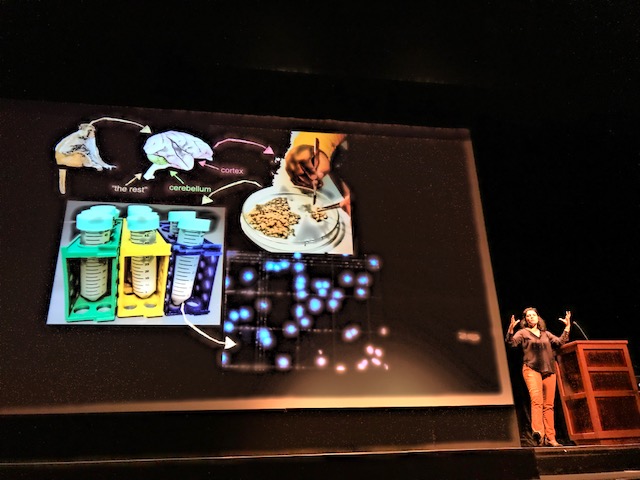
How to create brain soup: “Remove a brain, separate it into its different parts, chop each region into little pieces, grind those pieces in detergent – and you get brain soup!”
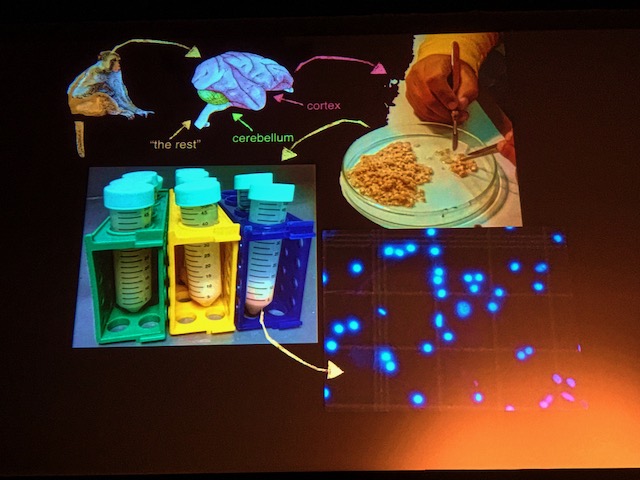
“I collected the nuclei floating in that soup (there is one nucleus per cell), and once you know how many nuclei are in 1 milliliter, you multiply by the amount of soup you have, and you have an accurate count!”
LEARN MORE: To Unlock the Brain’s Mysteries, Purée It
LEARN MORE: Three counting methods agree on cell and neuron number in chimpanzee primary visual cortex
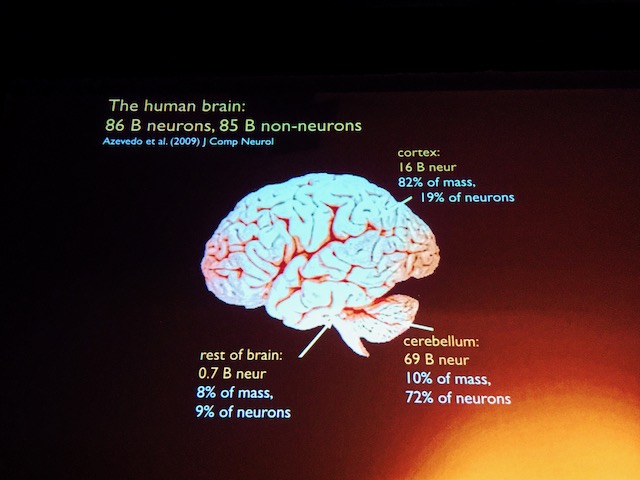
It turns out that the adult human brain has 86 billion neurons, but only 16 billion (19%) are found in the cerebral cortex! Most of your neurons (about 69 billion!) are located in your tightly packed cerebellum.
LEARN MORE: The role of the human cerebellum in performance monitoring
LEARN MORE: The Cerebellum’s Role in Movement and Cognition
“But the weird thing is that your cortex is not really necessary to move your body – that’s in the so called lower parts. Your cortex is important because of how it’s wired to the lower parts – copies of what you’re doing are sent to cortex. Combining all of this information – finding patterns, making memories, using memories to make decisions, make predictions and have a future – this is what the cortex does…”
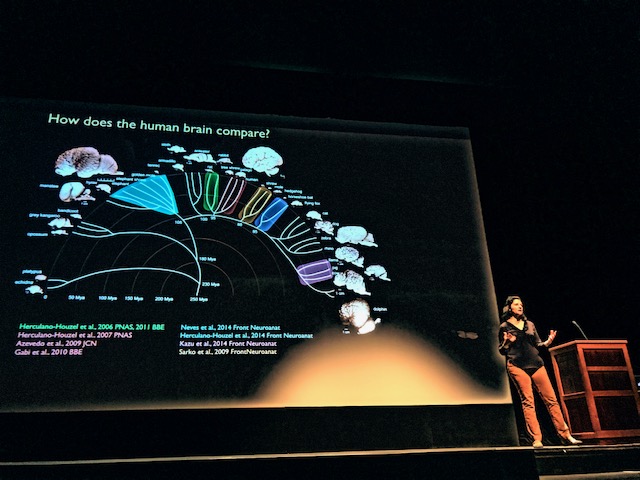
And we have more neurons in our cerebral cortex than other species. While the brains of Afrotheria clade mammals like the elephant are heavier, and have more neurons overall (257 billion!!), they’ve got around 5.6 billion neurons in the cortex. Recent unpublished work by Herculano-Houzel and colleagues demonstrate that cetaceans (whales) have brains that are less dense than primates, too…


LEARN MORE: The elephant brain in numbers
LEARN MORE: Cetaceans Have Complex Brains for Complex Cognition
Primates, in fact, have a denser cortex than any other mammal. We fit more neurons and synapses into smaller spaces…
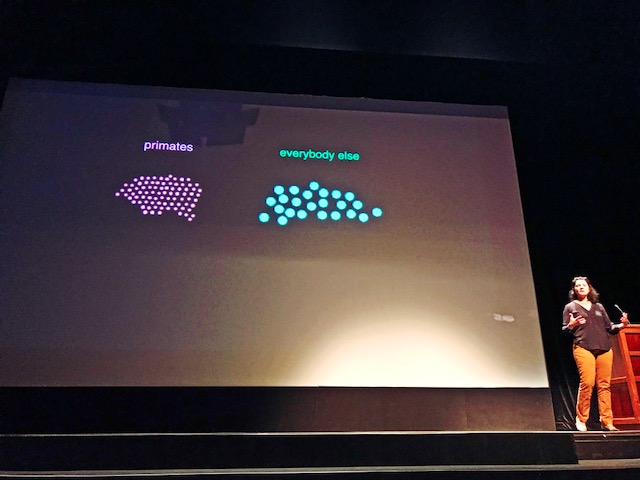
“Primates always have more neurons,” declared Dr. Herculano-Houzel. “If you’re not a primate, the more neurons you have, the bigger your neurons are. With primates the more neurons you have, they stay about the same, smaller size.” If a rodent, for example, possessed 86 billion neurons, they would be enormous, and their brain would weigh around 36000 grams! And to support such a huge brain, the rodent in question would weigh 89 TONS! (And they’d probably need to eat: Food of the Gods..?)…
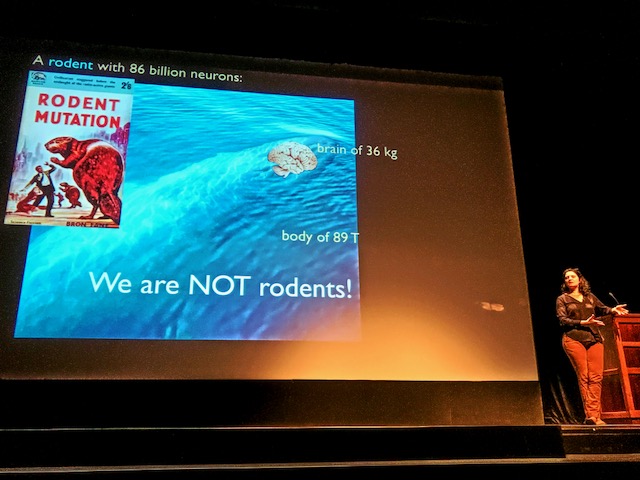
“Most mammals have fewer than a billion neurons in their cortex – with more than that you’re either very large, like an elephant, or a whale – or you’re a primate,” declared Dr. Herculano-Houzel. (Or a bird! Crows, for example, have even more neurons per unit area in their tinier but neuronally richer brains…)
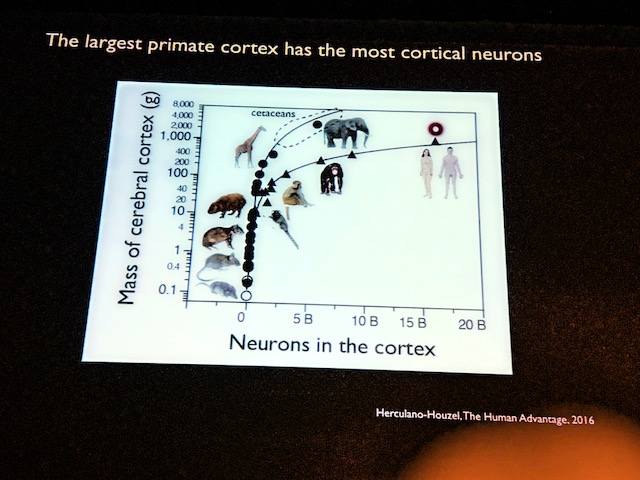
“Humans are right on the mark for primates…”
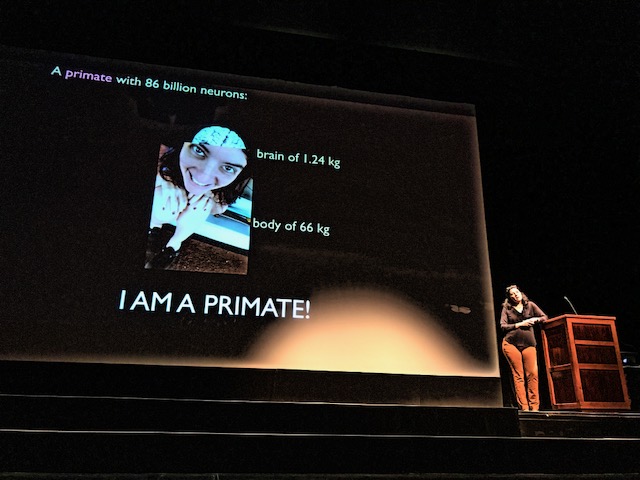
“We are not special…”
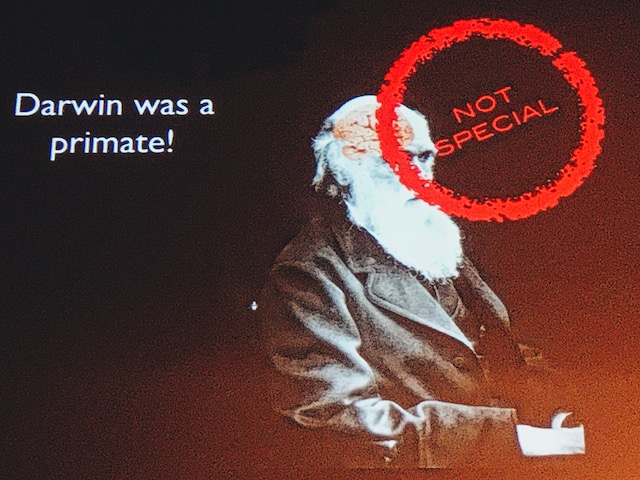
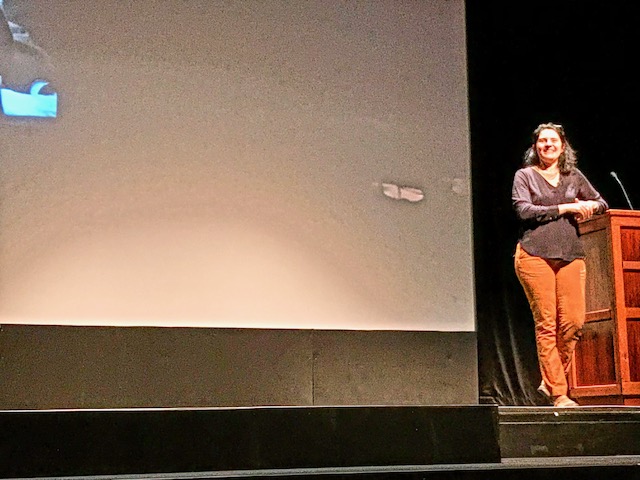
Dr. Herculano-Houzel suspects that Charles Darwin might have appreciated this fact…
LEARN MORE: Evolution of the human brain: when bigger is better
LEARN MORE: Gorilla and Orangutan Brains Conform to the Primate Cellular Scaling Rules: Implications for Human Evolution
LEARN MORE: Birds have primate-like numbers of neurons in the forebrain
LEARN MORE: The constitutive differential transcriptome of a brain circuit for vocal learning
So why is it advantageous to have a dense brain and a smaller body? Well, both cost significant energy, and elephants, again, spend most of their lives chewing! In fact, with our 86 billion neurons and smaller bodies, we still require a tremendous number of calories, and if we ate the way our primate ancestors did, suggested Dr. Herculano-Houzel, we actually couldn’t exist at all!
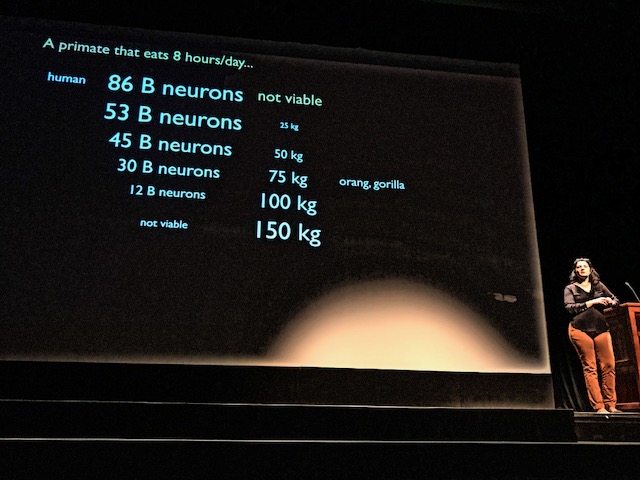
Yet about 2.5 million years ago, primates began using stone tools to cut up meat and grind down grains, what Dr. Herculano-Houzel called “cold cooking” – pre-digesting foods outside the body and making energy available with less effort and time.
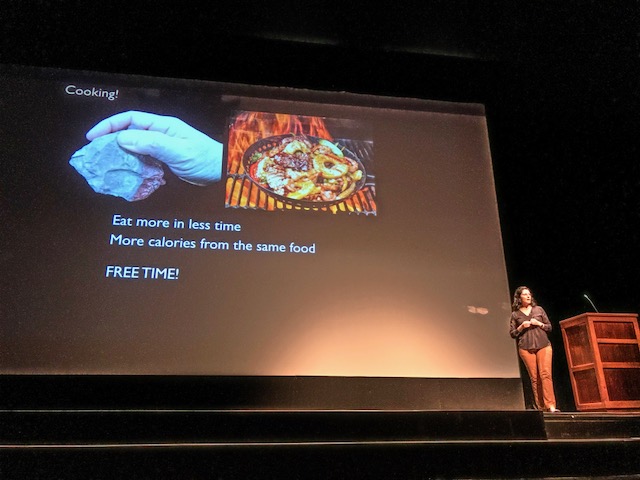
LEARN MORE: Occasional, obligatory, and habitual stone tool use in hominin evolution
LEARN MORE: The evolutionary neuroscience of tool making
And around 1.5 million years ago, we have evidence of cooking with heat, which releases even more energy and allows the efficient consumption of calories more quickly. “Suddenly more neurons are not a liability but an advantage, and cooking overlaps with that huge increase in the size of primate brains…”
LEARN MORE: The discovery of fire by humans: a long and convoluted process
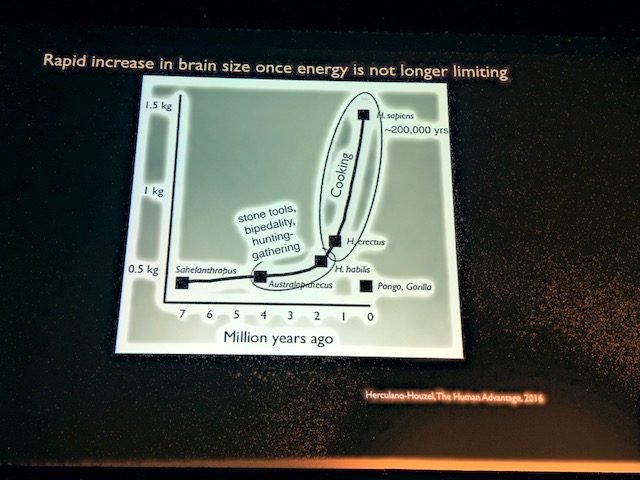
“Cooking is a beautiful example of a technology that allowed us to solve the problem of getting enough energy to feed our bodies and brains, offering more time to utilize that computational power and do more fascinating things with our lives…”
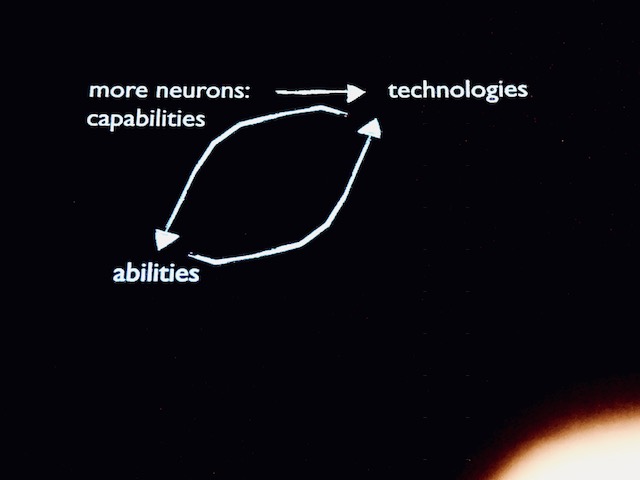
But there are other factors at work here, too, including technology and culture. Humans 200,000 years ago had the same brains, yet lived very differently.
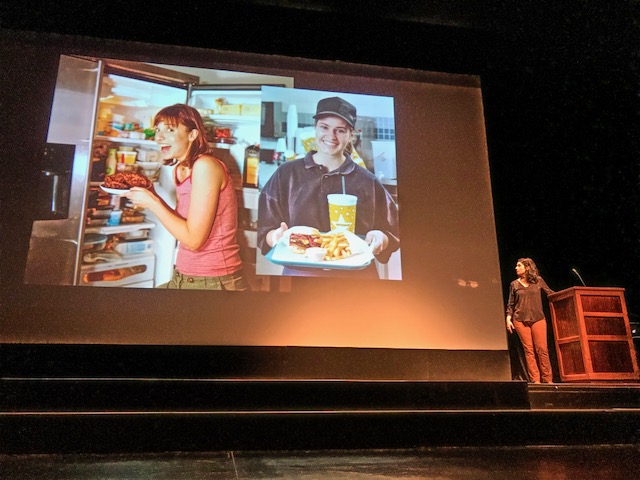
“When we’re born we have a certain biology,” explained Dr. Herculano-Houzel. We are “like a raw block of granite without meaningful shape, but all sorts of possibilities. How it gets shaped is determined by our environment – neurons and connections are shaped by experience…”
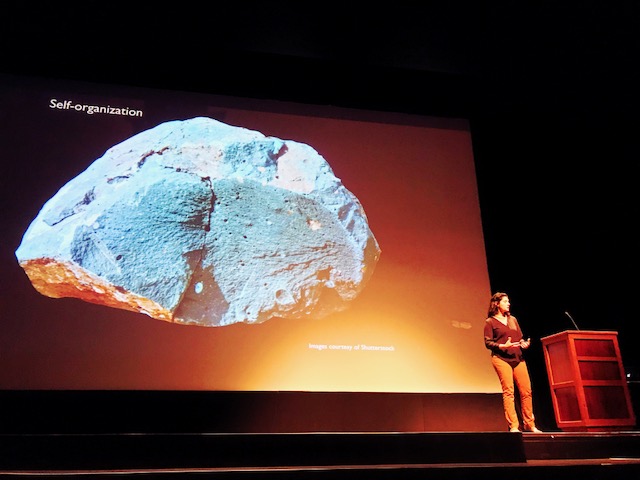
“I’m in awe of mentors and instructors and educators who care about shaping the brains of others, who keep the knowledge going from one generation to the next,” she said…
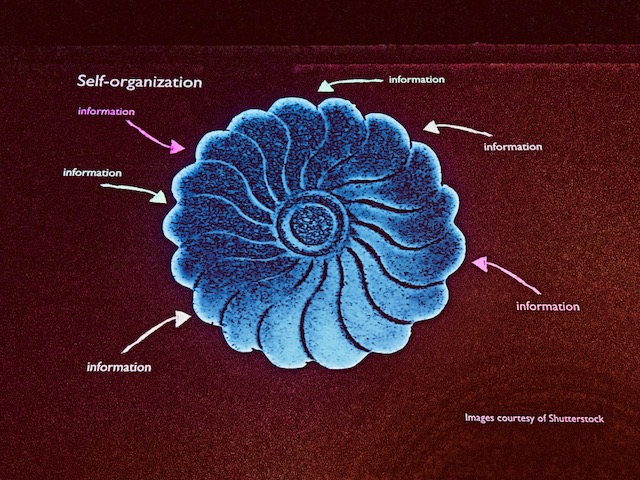

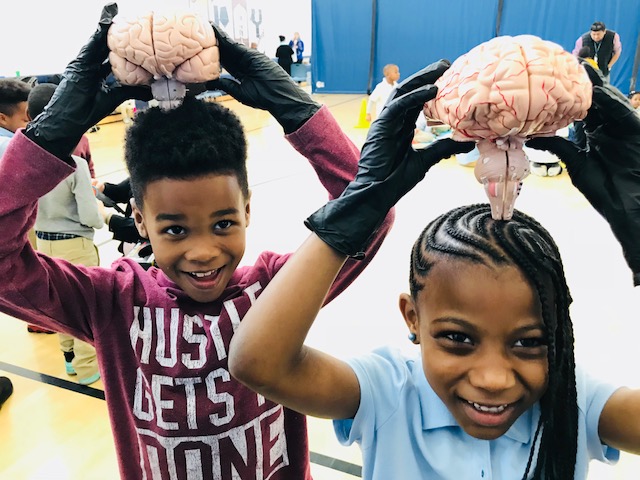
NW Noggin in action
We were inspired by this talk, and eager to continue our ongoing public efforts at arts-integrated neuroscience outreach and education through nwnoggin.org.

LEARN MORE: Nonprofit Noggins!
Many thanks to Kate Stout of the OHSU Brain Institute for welcoming our undergraduate and graduate volunteers!
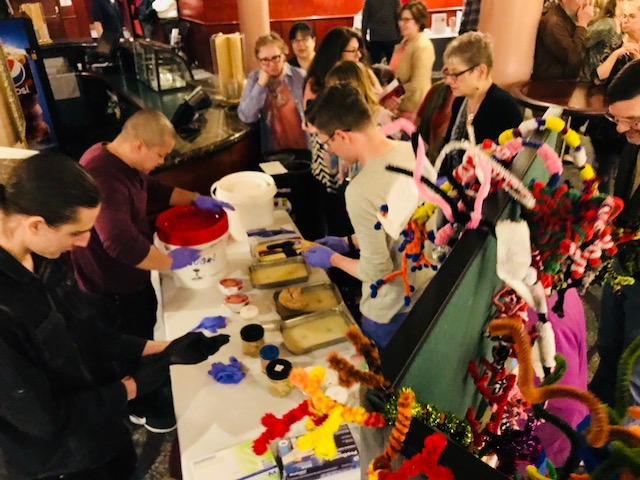

How to take a brain on a plane: Tips from Suzana Herculano-Houzel (as told to NW Noggin volunteer Jacob Schoen from OHSU/ONPRC)
- Hard plastic container
- Double plastic ziplock bags
- To be extra safe put the whole thing in another ziplock
- Add to your checked baggage and surround with clothes!
MORE OHSU BRAIN AWARENESS LECTURES ON THE WAY!
Nourishing Your Neurons






